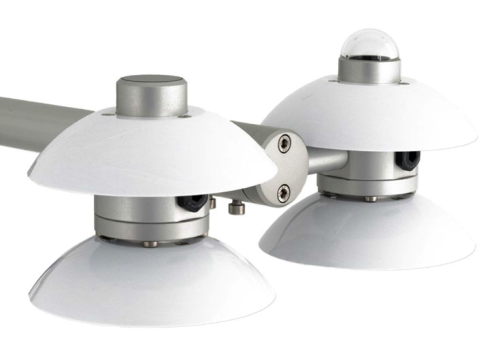
Robust—4-Komponenten-Strahlungsensor, der wenig Wartung erfordert






Überblick
Der NR01 ist ein Strahlungsbilanzsensor mit Forschungsstandard. Er bestimmt die Energiebilanz zwischen eingehender kurzwelliger und langwelliger infraroter Strahlung gegenüber von der Oberfläche reflektierter kurzwelliger und ausgehender Infrarotstrahlung. Unsere Logger messen die Ausgabe des NR01 und kontrollieren die interne Heizung.
Das NR01 ist ein Sensor für professionelle Energiebilanzforschung und wird auch in EC-Systemen eingesetzt.
Zu beachten: NR01s mit Seriennummern kleiner als 2313 verwenden die Halterung #21271, NR01s mit einer Seriennummer größer als 2312 brauchen sie nicht.
Lesen Sie mehrFunktionen und Vorteile
- Internal RTD provides temperature compensation of measurements
- Research-grade performance
- Internal 1-W heater reduces formation of dew and melts frost
- Separate outputs of short-wave and long-wave infrared radiation for better accuracy and more thorough quality assurance
- Robust—only requiring limited maintenance
Bilder

Zugehörige Produkte
Technische Beschreibung
The NR01 consists of a pyranometer and pyrgeometer pair that faces upward and a complementary pair that faces downward. The pyranometers and pyrgeometers measure short-wave and far infrared radiation, respectively.
The NR01 includes an on-board RTD to measure the radiometer’s internal temperature and a 1-W heater that minimizes the formation of dew and melts frost. To reduce current drain, a relay is typically used to turn on the heater only when the solar radiation is less than 20 W/m2.
Campbell Scientific's CR3000 and CR5000 dataloggers are ideal for measuring this radiometer. A CR1000 can also be used, but a 4WPB100 module is required to measure the internal RTD.
Kompatibel mit
Please note: The following shows notable compatibility information. It is not a comprehensive list of all compatible products.
Datenlogger
| Product | Compatible | Note |
|---|---|---|
| CR1000 (retired) | A 4WPB100 PRT Bridge Module is required to measure the internal RTD. | |
| CR1000X (retired) | A 4WPB100 PRT Bridge Module is required to measure the internal RTD. | |
| CR3000 | ||
| CR6 | ||
| CR800 (retired) | ||
| CR850 (retired) |
Halterungen und Masten
| Product | Compatible | Note |
|---|---|---|
| NR Sensor Mount |
Additional Compatibility Information
Mounting
To avoid shading or reflections and to promote spatial averaging, the NR01 should be mounted at least 1.5 m above the ground or crop canopy and away from all obstructions or reflective surfaces that might adversely affect the measurement. Campbell Scientific recommends mounting the NR01 to a CM300-series mounting pole at least 25 feet away from other mounting structures. The NR01 is attached to the CM300-series mounting pole via a CM204 or CM206 crossarm.
Spezifikationen
| Sensor | Hukseflux’s SR01 ISO-class, thermopile pyranometers, IR01 pyrgeometers, PT100 RTD |
| Measurement Description | Measures incoming and outgoing short-wave and long-wave radiation |
| Response Time | 18 s |
| Sensitivity | 10 to 40 μV W-1 m2 |
| Expected Output Range | -0.1 to +50 mV |
| Expected Accuracy for Daily Totals | ±10% |
| Heater | 90 ohm, 1.6 W (at 12 Vdc) |
| Operating Temperature Range | -40° to +80°C |
| Heater Current Drain | ~140 mA |
| Dimensions | 26.3 x 11.3 x 12.1 cm (10.4 x 4.4 x 4.8 in.) |
| Weight |
|
Pyranometer |
|
| Spectral Range | 305 to 2800 nm |
Pyrgeometer |
|
| Spectral Range | 4500 to 50,000 nm |
Dokumente
Broschüren Produkte
Handbücher
FAQs für
Number of FAQs related to NR01: 9
Alle anzeigenWenige anzeigen
-
As a general guide, go at least 1.5 m above the tallest plant (tree) in an ecosystem.
-
Campbell Scientific recommends that the sensor be mounted to a separate vertical pipe at least 25 ft from any other mounting structures.
-
Shading and reflection are important aspects to consider. The sensor should have a clear view of the upward hemisphere of the sky. To avoid shading effects and to promote spatial averaging, the sensor should be mounted at least 1.5 m above the ground surface.
-
It is possible that an older version of Short Cut is being used. Download the latest version of Short Cut.
For programming assistance, consult the NR01-L instruction manual. For additional assistance, contact Campbell Scientific.
-
As of June 2013, all of our current and retired net radiation sensors can be mounted using this kit. These include:
- Current sensors: CNR4-L, NR-LITE2-L, and NR01-L
- Retired sensors: CNR1, CNR1-L, CNR2-L, NR-LITE-L, and Q7.1-L
-
Only one 4WPB100 is needed to measure the internal PRT in the radiometer.
-
Mount the net radiometer so that no shadow will be cast on it at any time of day from obstructions such as trees, buildings, the mast, or the structure on which it is mounted.
Campbell Scientific recommends installing a net radiometer in an open area, away from the main weather station structure on a separate vertical mast. If it is necessary to install this sensor on the main tall tower (30 ft or taller), the sensor should be installed at the top of the tower. In the northern hemisphere, the sensor should be facing south. In the southern hemisphere, the sensor should be facing north. If the tower uses a solar power system (that is, solar panels), ensure that the solar panels are installed away from the main tower.
-
Because of the loss of IR radiation, nearly all thermopile instruments typically have a negative offset. This offset is most easily visible at night-time, when a small negative value is read instead of zero. This same offset is present during the daytime, but it is not as visible because of the large solar signal.
Another common issue involves leveling an instrument. Leveling a thermopile instrument can cause errors in the direct beam component because the cosine response is not correct. These errors are more notable when the sun is close to the horizon because the angle is so shallow.
Anwendungsbeispiele
Tropical volcanic islands are biodiversity hotspots where the Critical Zone (CZ) remains poorly studied. In......lesen Sie mehr


